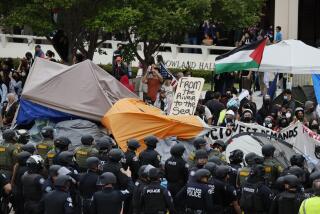Controversy at UC San Diego over nudity in visual arts class
- Share via
Reporting from San Diego — Over the last 11 years, professor Ricardo Dominguez has taught a course at UC San Diego titled Visual Arts 104A: Performing the Self.
As part of an assignment, students are asked to make a nude “gesture” in front of the class in a darkened room.
Such a gesture can be to disrobe, or to remain fully clothed and say something revealing about yourself that makes you feel vulnerable. Dominguez says he will be nude as well.
The class, which is not required, is popular with students, as is Dominguez, a tenured associate professor.
But a controversy has erupted after the mother of a UCSD student complained to a local television station that her daughter was required to be naked or risk failing the course.
“It bothers me; I’m not sending her to school for this,” the anonymous woman told KGTV. “It makes me sick to my stomach.”
As media requests began to swamp the university, the chairman of the visual arts department issued a statement supporting the class and the professor and noting that there has been misinformation about what 104A entails.
“The ambiguity around the question of ‘nudity’ and ‘nakedness’ is intentional,” Jordan Crandall, professor and department chairman, said in an email Tuesday. “It is intended to be provocative, to raise issues.”
This is not the first time Dominguez has been described as provocative.
Using a software program that continuously reloaded on the website of the UC president, Dominguez encouraged an act of “electronic civil disobedience” over the university’s policy on the rights of immigrants. Hundreds of students flooded the comment section of the homepage.
Dominguez said he wanted to blur the line between political advocacy and performance art.
“I’m interested in how different forms of power respond to this,” Dominguez told The Times in 2010. “Our work has always been to bring to the foreground what artists can do using available low-end technologies that can have a wider encounter with society than just the limited landscape of the museum, the gallery and the scholarly paper.”
Dominguez, 56, is co-founder of the Electronic Disturbance Theater, which has developed “virtual sit-in technologies” in support of indigenous communities in Mexico’s Chiapas state.
Among his projects has been development of a GPS cellphone app to help people crossing the U.S.-Mexico border at remote desert locations find where activists have placed water for them.
Students are advised at the beginning of 104A about the “nude/naked self” aspect. Some opt not to take the course.
“There are many ways to perform nudity or nakedness,” Dominguez said Tuesday, “summoning art history conventions of the nude or laying bare of one’s ‘traumatic’ or most tragic and vulnerable self. One can ‘be’ nude while being covered.”
The class allows students to learn about performance art “as practitioners … in a direct way,” Dominguez said. “It is not just a matter of reading about it or viewing slides.”
On an informal website where students are allowed to “grade” their professors, Dominguez rated an A.
“There is something liberating about an art form that does not limit you to canvas or paper, and I wanted my own work to continue in that trajectory,” senior Lisa Korpos said by email. “It has made me feel more courageous and confident in my aesthetic choices. I also feel more connected to my fellow artists. … My classmates and I support professor Dominguez fully.”
Twitter: @LATsandiego
More to Read
Sign up for Essential California
The most important California stories and recommendations in your inbox every morning.
You may occasionally receive promotional content from the Los Angeles Times.













